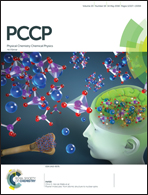A new surfactant–copper(ii) complex based on 1,4-diazabicyclo[2.2.2]octane amphiphile. Crystal structure determination, self-assembly and functional activity†
Abstract
A new surfactant–copper(II) complex [Cu(L)Br3] (where LBr is 1-cetyl-4-aza-1-azoniabicyclo[2.2.2]octane bromide) containing a transition metal in the head group has been synthesized and characterized. Physicochemical properties, thermal stability and 3D structure were determined using X-ray diffractometry, UV-vis spectroscopy, simultaneous thermogravimetry and differential scanning calorimetry combined with mass-spectrometry of evolved vapors. The study of the self-assembly and morphological features of associated structures was performed by potentiometry using a bromide ion selective electrode and fluorescence of pyrene and 1,6-diphenyl-1,3,5-hexatriene. The influence of the metal ion embedded into the surfactant structure on critical micelle concentration, degree of counterion binding, aggregation numbers and morphology of the associates was elucidated. High solubilizing capacity and complexation ability of the metal containing micelles with respect to Orange-OT hydrophobic dye and oligonucleotide were determined. Importantly, the functional properties of this metallosurfactant complex are much better compared to those of classical cationic surfactants bearing cyclic and acyclic head groups, LBr and the LBr–CuBr2 mixture. The new cationic metallosurfactant could be recommended for investigation in gene therapy.
![Graphical abstract: A new surfactant–copper(ii) complex based on 1,4-diazabicyclo[2.2.2]octane amphiphile. Crystal structure determination, self-assembly and functional activity](/en/Image/Get?imageInfo.ImageType=GA&imageInfo.ImageIdentifier.ManuscriptID=C8CP01954A&imageInfo.ImageIdentifier.Year=2018)


 Please wait while we load your content...
Please wait while we load your content...